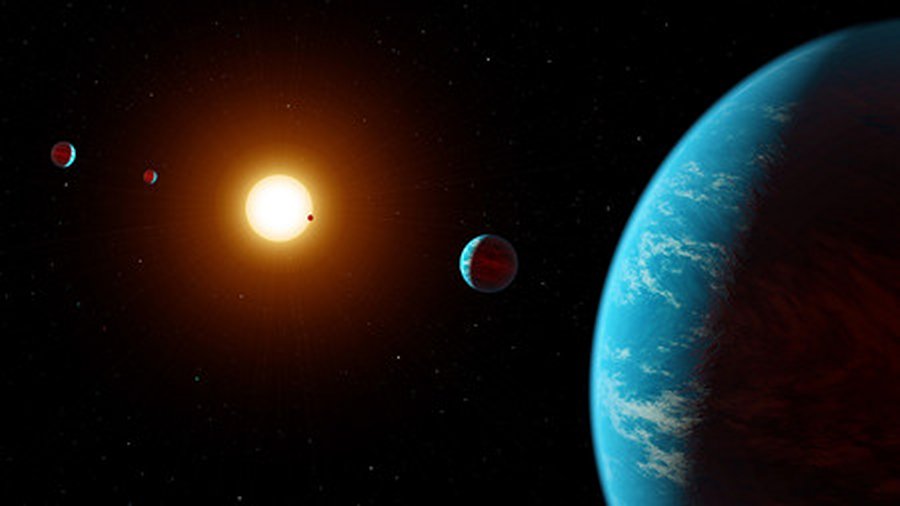K2-138 Five-Planet System Discovered By Citizen Scientists Using Data From NASA’s Kepler Telescope
Using data from NASA’s Kepler space telescope for signs of exoplanets, a group of citizen scientists discovered a distant planetary system that contains at least five exoplanets.
The system has been dubbed K2-138.
“People anywhere can log on and learn what real signals from exoplanets look like, and then look through actual data collected from the Kepler telescope to vote on whether or not to classify a given signal as a transit, or just noise,” said Caltech staff scientist Jessie Christiansen in a press release.

Artist’s visualization of the K2-138 system, the first multi-planet system discovered by citizen scientists. The central star is slightly smaller and cooler than our sun. The five known planets are all between the size of Earth and Neptune; planet b may potentially be rocky, but planets c, d, e, and f likely contain large amounts of ice and gas. All five planets have orbital periods shorter than 13 days and are all incredibly hot, ranging from 800 to 1800 degrees Fahrenheit. Credit: NASA/JPL-Caltech/R. Hurt (IPAC)
This is in fact, the first time that such a large system has been discovered entirely by volunteers, who used the online platform Zooniverse, launched by Christiansen in 2017.
“We have each potential transit signal looked at by a minimum of 10 people, and each needs a minimum of 90 percent of ‘yes’ votes to be considered for further characterization,” Christiansen added.
Researchers validated the set of planet signals as being “extremely likely,” according to Christiansen, to be signals from true planets. The planets are orbiting in an interesting mathematical relationship called a resonance, in which each planet takes almost exactly 50 percent longer to orbit the star than the next planet further in.
The researchers also found a fifth planet on the same chain of resonances, and hints of a sixth planet as well. This is the only system with a chain of unbroken resonances in this configuration, and may provide clues to theorists looking to unlock the mysteries of planet formation and migration.
All five planets – all between the size of Earth and Neptune – have orbital periods shorter than 13 days and are all incredibly hot, ranging from 800 to 1800 degrees Fahrenheit.
“The clockwork-like orbital architecture of this planetary system is keenly reminiscent of the Galilean satellites of Jupiter,” says Konstantin Batygin, assistant professor of planetary science and Van Nuys Page Scholar, who was not involved with the study.
“Orbital commensurabilities among planets are fundamentally fragile, so the present-day configuration of the K2-138 planets clearly points to a rather gentle and laminar formation environment of these distant worlds.”
“Some current theories suggest that planets form by a chaotic scattering of rock and gas and other material in the early stages of the planetary system’s life. However, these theories are unlikely to result in such a closely packed, orderly system as K2-138,” says Christiansen. “What’s exciting is that we found this unusual system with the help of the general public.”
The results are published at the 231st American Astronomical Society meeting.



 Creators of mankind
Creators of mankind Description of “Tall white aliens”
Description of “Tall white aliens” Where they came from?
Where they came from? About hostile civilizations
About hostile civilizations The war for the Earth
The war for the Earth “Tall white aliens” about eternal life
“Tall white aliens” about eternal life Video: “Nordic aliens”
Video: “Nordic aliens” Aliens
Aliens Alien encounters
Alien encounters The aliens base
The aliens base UFO
UFO Technology UFO
Technology UFO Underground civilization
Underground civilization Ancient alien artifacts
Ancient alien artifacts Military and UFO
Military and UFO Mysteries and hypotheses
Mysteries and hypotheses Scientific facts
Scientific facts


















